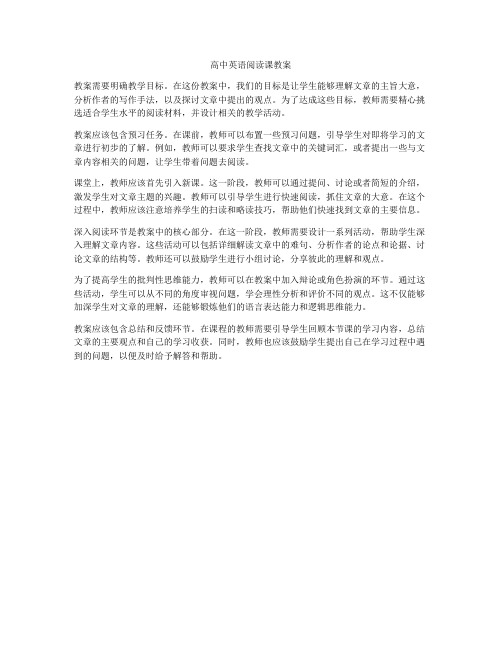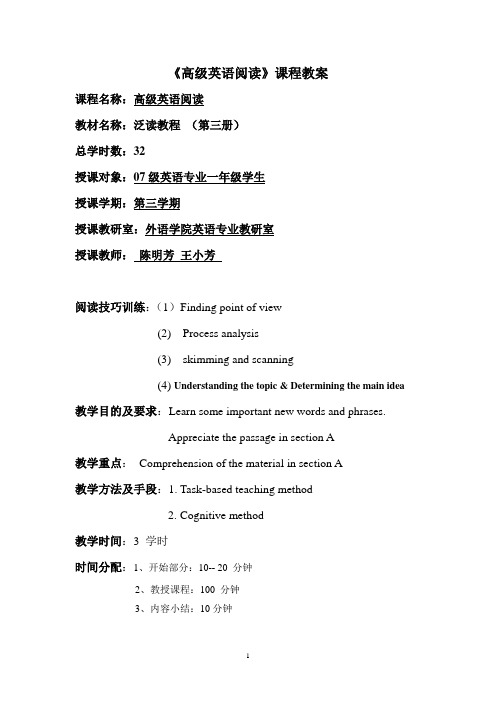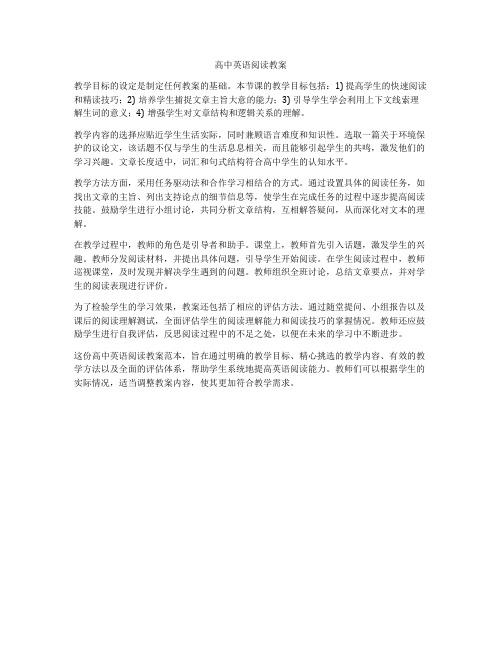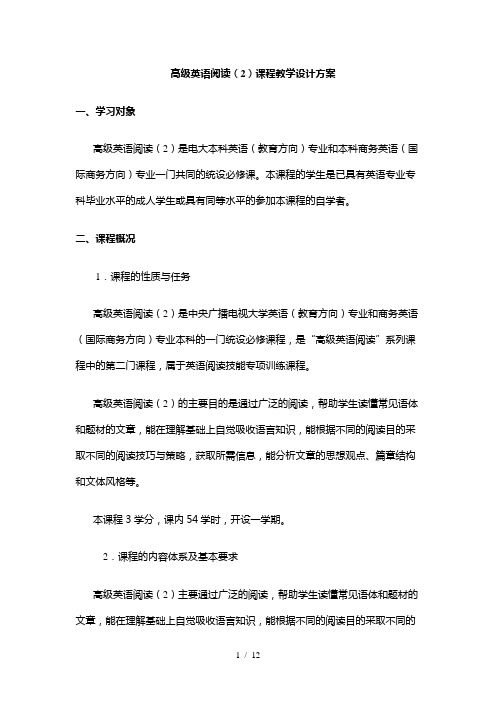高级英语阅读课程说明
高级英语阅读课程说明

阅读任务:
本单元学习完成 8 篇文章的阅读;每周在课前完成指定的阅读任务(第一周除外)
写作任务:
本单元学习完成 8 篇对应阅读任务的阅读报告(Reading Review/Reading Report) ,篇幅 为 500 词左右 每周在课前完成写作任务(第一周除外) ,提交打印文稿和电子文稿,无特殊原因,不 接受逾期提交的打印文稿和电子文稿; 对应第八篇文章的写作任务只需在考前提交电子 文稿 发送到任课教师指定邮箱的电子文稿的文件名为“学号+姓名+作业序号” ,如 “030140100 李双双(作业一) ” 由邮箱管理者整理后的压缩包文件名为“班级+作业序号” 字; Times New Roman 字体 批注 [WJ2]: 居中; 小四字; Times New Roman/宋体
批注 [WJ3]: 两端对齐;段首缩进;小 四字;Times New Roman 字体; 1.5 倍行距
成绩构成:
{平时成绩(各项任务完成情况) }*40% + {考试(指定阅读文章相关题目占 50%分值, 其它占 50%) }*60%
打印文稿的格式参考:
The Origins of Office Speak
030140100 李双双 (作业一) In the 1950s, two schools of thought began to emerge. At Carnegie Mellon, academics were working on what they called management science—a theory of decision-making inspired by the computers that had come out during World War II. Meanwhile, at MIT, three professors—Douglas McGregor, Edgar Schein, and Richard Beckhard—were creating a new field called organizational development. Schein, now 86, is largely credited with coining the term organizational culture (the linguistic cousin of corporate culture). “In the 1960s, there was an emphasis on humanistic psychology, involving the worker, because then they would work better,” he told me. “We were interested in how groups and leadership could be made more effective. So we started something called the human relations lab.” ……
《高级英语阅读》课程教学大纲

《高级英语阅读》课程教学大纲课程编号:18040042课程名称:高级英语阅读学时与学分:32学时/2学分先修课程:大学英语1、2、3册适应专业:大学二年级第四学期非英语专业英语四级成绩为425分以上的本科生一、课程性质、目的和任务A. 课程性质该课程为选修课,旨在通过练习已掌握的阅读技巧和学习新技巧来进一步提高学生的英语阅读能力,拓宽学生的阅读视野,使得学生在本课程学习结束时进一步提高英语阅读速度并能阅读高水平的英语读物。
B. 目的和任务:学生将进行较高水平乃至更高水平的英语阅读,进一步熟悉英语阅读过程中的步骤和技巧,进一步提高阅读技能并提高阅读速度,培养细致观察语言、假设判断、分析归纳、推理验证等逻辑思维能力,再度扩大词汇量,增加文化背景知识。
达到《大学英语课程教学要求》(教育)高教司,2007)对非英语专业本科生提出的阅读“较高要求”乃至“更高要求”,从深度、速度和广度上全方位提高学生的阅读技能。
二、课程教学内容及要求本课程题材广泛,体裁多样。
课程主要教材《高级英语阅读教程》照顾各专业学生的需要,所选文章内容新颖,信息容量大,具有时代性以及较强的趣味性。
教材的语言素材按题材大致可分为体育、电影、中西文化、环保、经济、法律、科技等。
目录:Unit 1 SportsUnit 2 MoviesUnit 3 Chinese CultureUnit 4 Cultural DifferencesUnit 5 Animal WorldUnit 6 Greenpeace MovementUnit 7 Environment ProtectionUnit 8 Biological and Genetic EngineeringUnit 9 Expo IndustryUnit 10 GlobalizationUnit 11 FinanceUnit 12 Motorcar Mobile-Phone and MicrosoftUnit 13 Space ExplorationUnit 14 International Law and Order为体现阅读课程特色,应有针对性地指导学生的阅读技能训练。
高中英语阅读课教案

高中英语阅读课教案
教案需要明确教学目标。
在这份教案中,我们的目标是让学生能够理解文章的主旨大意,分析作者的写作手法,以及探讨文章中提出的观点。
为了达成这些目标,教师需要精心挑选适合学生水平的阅读材料,并设计相关的教学活动。
教案应该包含预习任务。
在课前,教师可以布置一些预习问题,引导学生对即将学习的文章进行初步的了解。
例如,教师可以要求学生查找文章中的关键词汇,或者提出一些与文章内容相关的问题,让学生带着问题去阅读。
课堂上,教师应该首先引入新课。
这一阶段,教师可以通过提问、讨论或者简短的介绍,激发学生对文章主题的兴趣。
教师可以引导学生进行快速阅读,抓住文章的大意。
在这个过程中,教师应该注意培养学生的扫读和略读技巧,帮助他们快速找到文章的主要信息。
深入阅读环节是教案中的核心部分。
在这一阶段,教师需要设计一系列活动,帮助学生深入理解文章内容。
这些活动可以包括详细解读文章中的难句、分析作者的论点和论据、讨论文章的结构等。
教师还可以鼓励学生进行小组讨论,分享彼此的理解和观点。
为了提高学生的批判性思维能力,教师可以在教案中加入辩论或角色扮演的环节。
通过这些活动,学生可以从不同的角度审视问题,学会理性分析和评价不同的观点。
这不仅能够加深学生对文章的理解,还能够锻炼他们的语言表达能力和逻辑思维能力。
教案应该包含总结和反馈环节。
在课程的教师需要引导学生回顾本节课的学习内容,总结文章的主要观点和自己的学习收获。
同时,教师也应该鼓励学生提出自己在学习过程中遇到的问题,以便及时给予解答和帮助。
高级英语阅读课程教案

《高级英语阅读》课程教案课程名称:高级英语阅读教材名称:泛读教程(第三册)总学时数:32授课对象:07级英语专业一年级学生授课学期:第三学期授课教研室:外语学院英语专业教研室授课教师:陈明芳王小芳阅读技巧训练:(1)Finding point of view(2) Process analysis(3) skimming and scanning(4) Understanding the topic & Determining the main idea 教学目的及要求:Learn some important new words and phrases.Appreciate the passage in section A教学重点:Comprehension of the material in section A教学方法及手段:1. Task-based teaching method2. Cognitive method教学时间:3 学时时间分配:1、开始部分:10-- 20 分钟2、教授课程:100 分钟3、内容小结:10分钟Book 3Unit 1. Reading StrategiesSection Aletter perception, word perception, word pretest,Text Why Read Faster <5m>Warm-up questions:1.Why should we read fast?2.How many false ideas are listed?3.Can fast readers enjoy their reading?4.What is the normal speed of fast reading?5.How long does it take to double or triple slow reader’s rates?6.What does the final paragraph mean?Section B Common Fault and Eye Movement <10m> Warm-up questions1.How many subheadings are there in the passage?2.What are the common faults in the article?3.What does “Pointing at words” mean?4.What does “V ocalization’’ mean?5.What does “SUBVOCATION’’ mean?6.How do you cure subvocalization?7.How do you control your eye movement?8.How do you understand REGRESSION?Section C: 10minutesQuestion for passage 11.Why is reading important?Question for passage 21.What are the important factors in your reading?Question for passage31.What does a good reader mean?Exercises1.V ocabulary buildingPractice, practise, practical, practicableWorth, worthy, worthless, worthwhileVariety, vary, various, variationAbsorb, absorption, absorbent2.effective, efficient3.technique ,technology4.medium ,middle5.CLOZEKeys to blanksGoing, prediction, question, answers, predictions, tell, know, end, develop, worth.Unit 2 EducationSection ALetter perception.<30seconds>, Word perceptionText It’s Never Too Late for Success <5minutes>Warm-up questions1.How many subheadings are there in the article?2.How many examples are given in the article to prove the autho r’s idea?And who are they?3.What’s the main idea of the first paragraph?4.What is the author’s chief purpose?5.What is the author’s attitude toward young people?6.How do you understand “a hill of beans”?7.How do you understand “beatniks”?8.Explain the “glee club”, “prodigy”.Section BThe Education of Benjamin Franklin <9m>1. Introduction to Benjamin Franklin2.How much do you know about his early education?3.Who organized the first library in America?4.How did he manage to get books to read?Section C <10m>Questions1.What’s the main idea of the first article?2.What is the Montessori method of education for preschool children?3.What is the main idea of the last article?Exercises1. V ocabulary buildingKeys to blanks: mess, preference, aimlessly, marked, decisive, shipment, fiery, physically, action, housing,2.attitude aptitude3.count account4.talent intelligence5.Keys to close:Other, just, has, some, hope, see, that, without, if, ready, incorrect.Unit 3 Body LanguageSection ALetter perception< 15seconds>Word perception <15seconds>Keys to the word pretest:Hasty, dislike, suppose, ambition, belief, symbol, characteristics, notice, way of standing,Text Signals Without WordsWarm-up questions1.What is the title of this article?2.What does the first para. mean?3.Does a person is what he says he is?4.How do signals communicate people?5.What is the main idea of the para.9?6.What is the article mainly concerned with?7.Explain ‘snap judgment’Section B The Secret language of Barrier Signals <10minutes> Questions:1.How many forms of barrier signals are there in the article?2.What does the different form of signal mean?3.Explain the phrases:4.fend off the other person ; fiddle with one’s cuff; cuff-fumble;Section C 10minutes1. What does the ‘KINETICS’ mean?2.Do gestures vary among cultures and within cultures?3.In what kind of situation do we use ‘blank stare”?4.When we glance away, what do we often do?5.Explain ‘EMBLEM’6.What is chief idea of the last article?Exercises1.V ocabularyAspire, inspire,Badge, token,Contemporary, temporary2.Keys to closeCommunicate, ways, using, in, of, message, have, is, meaning, to, eyes,Unit 4 AnimalsSection ALetter perception, word perception, <30seconds>Word pretest: 1-10: remove, fur, only, place where they often go, cleverness, lures, forbidden, animals that eat other animals, comprise, appointment,Text Little Brother of the WolfQuestions:1.What is the title of this article?2.Who is the little brother wolf?3.Why has the little coyote to be clever?4.What is the “Humane Coyote –Getter?5.Why do you say the coyote is a good pet?6.Who is Gerald Coward?7.What is the main idea of this article?Section B Marmosets: The World’s Smallest MonkeysQuestions1.Explain the word “marmoset’2.What are the characteristics of marmosets?Section C <10M>Questions1.What is the main idea of the first passage?2.What does the eagle represent in Mexico?3.What does the eagle symbolize in Christian religion?4.What is the main idea of the second passage?5.What is the main idea of the third passage?Exercises1. V ocabulary:Desert, dessert,Favourable, favouriteReward, award3.Keys to close: parents, idea, at, seen, landmarks, migrate, guide, pole,effect, this, if, experimentsUnit 5 HistorySection A1.Letter perception, word perception<30seconds>2.word pretst:1-10: evident, guesses, concluded by reasoning,consistence, able to read and write, comprise, winding, focus, supportor, declared,Text: Some Theories of HistoryQuestions:1.What is the title of this passage?2.What is the author’s purpose?3.What is the first theory?4.What is the second theory?5.What is the third theory ?6.What is the forth theory?Section B Abraham Lincoln AgainQuestions1.How do you understand the title?2.Who is the hagiographer?3.What is the story about?4.What is the best book about Lincoln?5.Explain “archetype, substantive, flinch, infiltrate”Section C <10MINUTES>Questions1.What does ‘megaliths’ mean?2.Who placed megaliths?3.What is the main idea of the article?4.How was the earliest histories told by the people?5.What is the main idea of the last passage?Exercise 11.historic, historical2.human, humane3.circle, cycleExercise 2 CloseKEYS: existed, over, head, body, found, language, use, single, passed, above, survival, overcoming,Unit 6 LanguageSection A* Letter perception ; word perception <30seconds.●word pretest :1-12:makeup, expensive and unnecessary goods,foreign, use, sum of money lent, utilize, absorbed, pronunciational, kind, foreign, delicate, wildly emotional,●TEXT V ocabulary Change●Questions:1.What is the title of the article?2.How many subheadings are there in the passage? And what arethey?3.What is the main idea of the para.1?4.What is the main idea of para.2?5.What is the main idea of para.4?6.Where did the most of learned words come from?7.How do you understand “widening”?8.How do you understand “narrowing”?Section B Give Up Six Words and Change Your LifeQuestions:1.What is the text mainly about?2.How do you see the world about us?3.What does six words really mean?Section C <10Ms>Questions:1.What is the first article mainly about?2.What is “Yankee Doodle”?3.What is the second passage about?4.Who is Higgins?*Exercise 1. V ocabulary1.peculiar, particular2.access, assess3.source, resource*Exercise 2. Close:Reading Skills : Scanning*Scanning is looking for the exact answer to a specific question.1.finding a word in the dictionary2.locating a certain street or town on a map3.finding a certain train’s departure time4.looking for news5.locating information in a book index*How to scan1.Note the time2.read carefully the first question3.scan the para.s4.mark your answers5.go on to the second question6.make a note of your finishing timeUnit 7 SpaceSection A*Letter perception, word perception, <30seconds>*word pretet:1-8: promise, hurt, financial plan, maintain, large, private citizen, in complete agreement, structure,*Text Has the Bright Promise of the Space Program Faded?Questions:1.How many subheadings are there in the article? And what arethey?2.What is the symbol of the brave human spirit?3.What is the Rogers Commission about?Section B Probing the UniverseQuestions:1.Who was the first man landing on the moon?2.Why did we say the ancient Egyptians were marvelous?3.What is the theory of the earth?4.What is the theory of the sun?5.How much do you know about Galileo?6.What does the author mean at the end of the article?Section C1.What is the first passage about/2.what is the second passage about?3.what is the third passage about?*Exercise 1 V ocabulary1.inquire, requireparable, compatible*Exercise 2 CLOSE1-10. satellite, some, space, wondered, life, kind, orbiting, have, living, were, believe, own, solar, where ,likely, living , throughUnit 8 WOMENSection A*letter perception & word perception*word pretst:1-10:Text Woman in Education, Sports and MediaQuestions:1.What is the primary concern of the American women’s movement?2.How did women play a role in education?3.What is the position of women in sports?4.What is the position of women in media?Section B Women in Science1.What is the position of women in science?2.How does the author intend to say?3.What is true of science?Section C <10ms>Questions:1.What is the main idea of the first article?2.What is the second passage about?3.What do you know about diagraph?*EXERCISE 1 vocabulary1.career, job2.principle, principal3.female, feminine*Exercise 2. CLOSE:1-15: acceptable, domestic, property, wages, divorce, husband, claims, legal, suit, permitted, make, excluded, lacked, belonged, determined,Unit 9 CitiesSection A The Unforgettable Hong KongQuestions:1.How many subheadings are there in this article and what are they?2.Why do we say it’s unforgettable?3.What do you know about stone lions?4.What are celebrated in HongKong? Section B LONDENQuestions:1.What are the beautiful spots?2.Tell something about British Museum3.tell something about Buckingham Palace4.tell something about Houses of Parliament5.tell something about Tower of London6.Tell something about Westminister Abbey Section CQuestions:1.What is the first article about?2.What city is mentioned in the article?3.Where is Atlanta?4.Where is Toronto?*Exercise 1. VOCABULARY1.recreate, recreation2.rhyme, rhythm*Exercise 2. CLOSEUnit 10 Cross-Cultural CommunicationSection A A Cultural Context: Americans, Germans, and English Questions:1.What is the German proxemic pattern about space?2.What is American pattern about space/3.What is English pattern?Section B CustomsQuestions:1.Why do people have different habits?2.Is there no raw human nature?3.What’s your opinion about culture?Section CQuestions:1.What is American rule?2.What is the second passage about?3.What is the important communicative task discussed in this passage? *Exercise 1:1.assure, ensure2.arise, raise,rise3.cue, clue*Exercise2; CLOSE 1-10well ,isolating ,is, own, close, need, look, order, respect, follow, prior,Unit 11 Information RetrievialSection A The Management of KnowledgeQuestions:1.What are the new challenges mentioned in the article?2.What system is used in American library?3.What is MPEG stand?4.What do they pay attention to in nowadays American?Section B LibraryQuestions:1.How many subheadings are there in the passage?2.What are the most common kinds of libraries?3.Which is the world’s largest library?4.What is the topic about last two para.s?Section CQuestions1.What do you know about the advertisements?2.How do you read advertisements?*Exercise 1:1.adopt, adapt2.council, counsel*Exercise 2 Close 1-10:library, amounted, own, burned,same,countries,send,propoal ,libraryUnit 12 EnvironmentSection A Reducing EmissionQuestions:1. How many subheadings are there in the passage?And what are they?2. Why do we say today’s pollution problem is serious?3. What produce zero emission?Section B Energy and Environment1.What are the advantages of rushing stream and wind over coal, oil andgas?2.What cities are the main industrial cities?Section CQuestions1.What are the marks of uncivilized society?2.What are the main pollutants of the air?3.What is the last passage about?*Exercise 11.equivalent counterpart2.creation innovation3.impress compress*Exercise 2 Close:solve,communities,creative,disposal,resources, recycling,waste, increaseSection A The Interaction of Body and Mind Questions:1.How many subheadings are there in the passage?2.What is the concept of psychosomatic illness?3.What do you infer from the para2?4.What do you infer from para3/5.What do you infer from para4?6.What do you conclude from para6?Section B When to Worry About a Fever Questions1.What is the concept of a fever?2.How do you cure a fever?3.What are the wrong ideas about a fever? Section CQuestions1.When is the riskiest time for a heart attack2.Why does quackery thrive in modern times?*Exercise 11.remedy, recipe2.alter, alternate3.knowledge, acknowledgeSection A Charles Darwin and the Evolutionary Revolution Questions:1.Introduction to Darwin2.What do you know from para1?3.What is the intellectual world of Darwin’s time?4.Who was Robert FitzRoy?Section B Darwin and the Beagle*Tell something about the BeagleSection C1.What is the relationship between reptiles and birds?2. What do you infer from the passage?*Exercise 11.evolve, revolve2.dismal, dismay3.attribute, contribute*Exercise 2.fill in the blanks:1.reluctant,2.evolution,3. attributed,4.catastrophic,5.associate,6.indifferent, 7. emerged, 8. stirUnit 15 TransportationSection A Frank TurnerQuestions:1.Who is Frank Turner?2.What do you know about his father/3.How do you understand ‘Detroit’s automakers prospered’?4.What is Al Gore’s father?5.What is the author’s attitude to interstate highways?Section B Can We Prevent a Grim Future for American TransportationQuestions:1.How much do you know about the Federal highway program?2.What does the author believe about American transportation?3.What is the percentage of American people’s living?Section CQuestions:1.What are the traffic signs discussed in this article?*Exercise1. VOCABULARY1.metaphor, simile2.ultimate, unanimous*Exercise 2 Fill in blanksUnit 16 TimeSection A The CalendarQuestions:1.What is para4 about /2.What do you infer from para7?3.How much do you know about the Babylonian calendar?4.What does ‘leap year’ mean?5.What is the author intention about this article?Section B The V oice of TimeQuestions:1.How do you understand ‘time talk’?2.What is American rule about time?3.In what way do Americans show their sincerity and respect to theirguests about time?Section CQuestions1.When was the first mechanical clock invented?2.How did ancient people tell time?3.What is the last article about?*Exercise1 Fill in the blanks1.representation. presentation2.base. BasisUnit 17 TelevisionSection A Daytime TV Talk Show-What’s Their Appeal? Questions:1.What do you from para1?2.What does the author imply in the last para.?Section B Television: the Cyclops That Eats Books Questions:1.Why do we say TV is destroying English language?2.What is the main concern of TV?3.What is the author’s attitude toward TV?Section CQuestions1.What does BBC stand for?2.In what way is BBC1 different from BBC2?*Exercise1 Fill in the blanks1.emerge immerse2.dominant dormantUNIT 18 Poetry1.Introduction to poetry2.What is versification?3.How many kinds of feet are there in poetry?4.How do you scan a line?5.What is alliteration?6.What is couplets?7.What is stanzas?8.What is free verse?9.What is the Sonnet?10.What is the difference between Shakespearean and Italian?。
大学英语高级阅读教案

教学目标:1. 让学生了解烹饪艺术的历史和文化背景。
2. 培养学生快速阅读和深入理解文章的能力。
3. 扩大学生在烹饪相关词汇和表达方面的词汇量。
4. 培养学生的批判性思维和写作能力。
教学对象:大学英语高级水平学生教学时间:2课时教学准备:1. 教科书《大学英语高级阅读教程》2. 相关烹饪艺术图片和视频资料3. 白板和马克笔4. 课堂活动材料教学过程:第一课时一、导入1. 通过展示烹饪艺术图片和视频,激发学生对烹饪艺术的好奇心。
2. 引导学生谈论烹饪艺术在日常生活中的重要性。
二、快速阅读1. 让学生快速浏览课文,了解文章大意。
2. 邀请学生分享阅读过程中遇到的生词和短语。
三、精读1. 针对课文内容,进行详细讲解,帮助学生理解文章结构、主题和论点。
2. 分析烹饪艺术的历史、文化背景以及发展过程。
3. 引导学生关注烹饪艺术在不同国家和地区的影响。
四、课堂活动1. 将学生分成小组,讨论烹饪艺术对人类饮食文化的影响。
2. 小组代表进行分享,其他学生进行补充和评价。
第二课时一、复习1. 回顾上节课所学内容,检查学生对烹饪艺术历史、文化背景的了解程度。
2. 邀请学生分享自己了解到的烹饪艺术知识。
二、写作训练1. 针对课文内容,布置写作任务:以烹饪艺术为主题,写一篇短文,阐述其对人类饮食文化的影响。
2. 学生进行写作,教师巡回指导。
三、课堂展示1. 学生展示自己的写作成果,其他学生进行评价和反馈。
2. 教师总结本次课程,强调烹饪艺术的重要性。
教学评价:1. 课堂参与度:观察学生在课堂上的发言和互动情况。
2. 阅读理解能力:通过学生的快速阅读和精读表现,评估其对文章内容的理解程度。
3. 写作能力:通过学生的写作成果,评估其在烹饪艺术主题下的写作能力。
教学反思:1. 教师应关注学生的阅读兴趣,结合实际案例,提高课堂互动性。
2. 注重培养学生的批判性思维,鼓励学生发表自己的观点。
3. 结合写作训练,提高学生的英语写作能力。
《高级英语》教学大纲

《高级英语》课程教学大纲一、课程说明1.课程的性质与目的《高级英语》是一门训练学生综合英语技能尤其是阅读理解、语法修辞与写作能力的课程。
课程通过阅读和分析内容广泛的材料,包括涉及政治、经济、社会、语言、文学、教育、哲学等方面的名家作品,培养学生对名篇的分析和欣赏能力、逻辑思维与独立思考的能力,拓宽学生的人文学科知识和科技知识,增强学生对文化差异的敏感性,加深学生对社会和人生的理解,帮助学生继续打好语言基本功,牢固掌握英语专业知识,巩固和提高学生的英语语言技能以及综合运用英语进行交际的能力。
2.教学要求和任务1)要求学生能读懂难度相当于美国Times 或New York Times的社论和政论文;能读懂难度相当于The Great Gatsby的文学原著,难度相当于The Rise and Fall of the Third Reich 的历史传记;语言能力较高的学生要求能读懂一般英美报刊杂志上的社论和书评、英语国家出版的有一定难度的历史传记和文学作品。
要求在理解的基础上分析文章的思想观点、语篇结构、语言特点和修辞手法。
2)选材涉及政治、经济、社会、语言、文学、教育、哲学等方面的名家作品,体裁多样。
学生阅读后能够进行说、写、译方面的表达:能够比较系统地口头描述所阅读材料的概要,能够比较流畅和准确地跟同学交流自己的思想和观点;能够写出故事梗概、读书报告等,还能够撰写课程论文以及正式的书信等,要求内容充实、语言正确,表达得体,具有一定的思想深度;能够运用翻译理论和技巧对所阅读的材料进行英汉互译,译文忠实原文,语言通顺。
3)学生能够熟练使用各种英英词典、大型百科全书,独立解决语言问题和部分知识方面的疑难问题,能够有效地通过计算机网络查阅资料,获取知识,独立从事某些简单课题研究。
4)学生能够加深对当代英语的不同侧面,西方社会和文化等的认识,能够在扩大知识面的同时习得语言,提高文化素养。
二、学生在选读本课程之前应具有的语言知识和能力1) 具有比较扎实的语言基本知识,掌握一定的听、说、读、写、译技能以及各项技能的综合运用能力;2)大量阅读英语简易读物,基本看懂英语原著,具有较好的语言理解能力、分析能力、综合能力与概括能力;具有一定的思维能力和语言学习过程中的发现问题和解决问题等创新能力;3)具有课外自主收集相关阅读材料进行拓展性学习的能力;4)具有英汉语言和英汉文化差异的敏感性,掌握一定的跨文化交际能力。
高中英语阅读教案

高中英语阅读教案教学目标的设定是制定任何教案的基础。
本节课的教学目标包括:1) 提高学生的快速阅读和精读技巧;2) 培养学生捕捉文章主旨大意的能力;3) 引导学生学会利用上下文线索理解生词的意义;4) 增强学生对文章结构和逻辑关系的理解。
教学内容的选择应贴近学生生活实际,同时兼顾语言难度和知识性。
选取一篇关于环境保护的议论文,该话题不仅与学生的生活息息相关,而且能够引起学生的共鸣,激发他们的学习兴趣。
文章长度适中,词汇和句式结构符合高中学生的认知水平。
教学方法方面,采用任务驱动法和合作学习相结合的方式。
通过设置具体的阅读任务,如找出文章的主旨、列出支持论点的细节信息等,使学生在完成任务的过程中逐步提高阅读技能。
鼓励学生进行小组讨论,共同分析文章结构,互相解答疑问,从而深化对文本的理解。
在教学过程中,教师的角色是引导者和助手。
课堂上,教师首先引入话题,激发学生的兴趣。
教师分发阅读材料,并提出具体问题,引导学生开始阅读。
在学生阅读过程中,教师巡视课堂,及时发现并解决学生遇到的问题。
教师组织全班讨论,总结文章要点,并对学生的阅读表现进行评价。
为了检验学生的学习效果,教案还包括了相应的评估方法。
通过随堂提问、小组报告以及课后的阅读理解测试,全面评估学生的阅读理解能力和阅读技巧的掌握情况。
教师还应鼓励学生进行自我评估,反思阅读过程中的不足之处,以便在未来的学习中不断进步。
这份高中英语阅读教案范本,旨在通过明确的教学目标、精心挑选的教学内容、有效的教学方法以及全面的评估体系,帮助学生系统地提高英语阅读能力。
教师们可以根据学生的实际情况,适当调整教案内容,使其更加符合教学需求。
高级阅读课程教学大纲

高级阅读课程教学大纲课程名称: 高级阅读英文名称: Advanced Engl i sh Read i ng课程编号: X4100331学时数: 32学分数: 2.0适用专业: 英语专业一、课程的性质和任务本课程系英语专业四年级时所开设的几门主要专业选修课之一。
英语阅读课的目的在于培养学生的英语阅读理解能力和提高学生的阅读速度;培养学生细致观察语言的能力以及假设判断、分析归纳、推理检验等逻辑思维能力;提高学生的阅读技能, 包括细读、略读、查阅等能力;并通过阅读训练帮助学生扩大词汇量、吸收语言和文化背景知识。
阅读课教学应注重阅读理解能力与提高阅读速度并重。
教材应选用题材广泛的阅读材料, 以便向学生提供广泛的语言和文化素材, 扩大学生的知识面, 增强学生的英语语感的培养学生的阅读兴趣。
二、课程教学内容的基本要求、重点和难点阅读技巧介绍:第一章文章的主旨和大意第一节掌握短文主题句(重点)第二节掌握段落主题句(重点)第三节把握语篇段落的展开第二章阐述主旨的事实和细节第一节词语和句型上的转换第二节排除式结构第三节长句句法结构(难点)第三章判断超纲词汇和短语的意义第一节根据上下文推断词意(难点)第二节根据构词法推断词意(重点)第四章句子的意义及逻辑关系第一节各句子之间的指代关系(重点)第二节文章各段落之间的关系第五章判断推理和引申第一节暗指题(难点)第二节推理题第三节结论题(重点)第六章领会作者的观点和态度第一节正确理解作者真正的观点(难点)第二节正确推断作者的语气态度(难点)本课程阅读练习材料虚构类和非虚构类兼收, 小说、演说词、科技文章、文选评论、诗歌、散文等题材广泛, 且均以原著本为主。
基本要求:1.要求学生理解深刻, 对整篇语意有全面的领会和掌握, 使学生的文学修养和语言修养有所提高。
2.在第四级的基础上, 继续抓好语言基本功和训练, 要求学生在应用语言时更熟练, 也更精确。
为此, 在提高阅读理解能力的同时, 继续围绕语法和词汇和作一定量的练习和讲解, 在第七阶段尤为如此。
高级英语阅读教学大纲

“高级英语阅读”课程教学大纲英文名称:Advanced English Reading课程编号:31018000课程类型:大学英语后续课学时:32 学分:2适用对象:山东大学非英语专业三级班学生先修课程:大学英语1-4 册使用教材及参考书:1. 《博采英语》(阅读3)主编: Linda Robinson Fellag 清华大学出版社, 2005年2. 《高级英语阅读教程》主编: 王守仁, 程冷杰外语教学与研究出版社, 2006年3. 《朗文高级英语阅读》编著: Rose Wassman, Lee Ann Rinsky 中国电力出版社,2007年4. 《大学英语实用阅读》(上)主编:周俊英中国人民大学出版社, 2005年一、课程性质、目的和任务A.课程性质:该课程为山东大学非英语专业三级班学生后续课,本课程旨在通过练习已掌握的阅读技巧和学习新技巧来进一步提高学生的英语阅读能力;使学生在本课程学习结束时能借助词典能阅读英语原版书籍和英语国家报刊杂志上的文章,并能比较顺利地阅读自己专业有关的综述性文献。
B.目的和任务:1.学生将继续学习各种类型和题材的英语阅读文章。
2.学生将进一步熟悉英语阅读过程中的步骤以及技巧。
3.学生将进一步提高阅读理解技能以及阅读速度。
4.学生将进一步提高独立学习的能力二、课程教学内容及要求三、考试及评估本课程学期总评成绩分为两部分:平时成绩(30%)、期末考试成绩(70%)平时成绩:出勤情况+课堂表现:5%平时作业(小组活动;阅读笔记;平时测试): 15%学期项目:10%期末考试:70% (在期末集中安排考试,考试内容由任课老师确定。
四、大纲撰写人王鹏王凯军。
高级英语阅读教程教学设计

高级英语阅读教程教学设计简介在高级英语阅读教学中,学生们已经具备了一定的英语基础,因此需要更加深入和系统的阅读教学来提高他们的英语水平。
本文将介绍一种高级英语阅读教程教学设计,帮助教师更好地促进学生的英语阅读能力。
教学目标•帮助学生提高阅读英语的速度;•增强学生的英语阅读技巧,如索引阅读、精读与泛读;•增强学生的词汇量和语法理解能力;•提高学生的自我学习能力和阅读策略;•通过阅读提高学生在科学、文化、历史等领域的相关知识。
教学方法1. 教学策略•培养学生的阅读习惯。
每天坚持读英语材料,不断提高阅读速度和阅读量。
•强调学习策略,引导学生掌握一些行之有效的阅读策略,如扫描技巧、预测技巧、联想技巧、归纳技巧等。
•培养学生使用词典和阅读目录的能力,并鼓励学生积累相关课外阅读材料。
•鼓励学生通过集体讨论和小组讨论的方式,提高学生的口语和表达能力。
2. 教学内容•阅读理解:选择有代表性,语言难度适中,内容丰富的文章,引导学生多角度理解文章,掌握简单的新词汇和语法规则。
•阅读速度:选择一些简单的文章引导学生提高读英语的速度,打好阅读基础;同时也需要选择一些更为复杂的文章,通过多次阅读和分析来提高阅读速度。
•阅读技巧:在阅读教程中,鼓励学生使用不同的阅读技巧来理解文章,提高阅读效率。
例如,通过阅读目录和索引,找到所需信息,节约时间和精力;通过预测和判断,提高对文章中认知的理解。
3. 教学步骤1.问题导入:通过语言、图片、音频或视频引导学生感受与话题相关的意境和文化背景。
2.全文阅读:让学生读一遍文章,发现文中的重点、逻辑、和参照点等。
3.阅读理解:让学生分小组阅读一段有代表性的文章,并通过细节、主旨、推断、分析等方式掌握文章中的信息。
4.技巧指导:如何使用阅读技巧来更好地理解文章,例如通过词典查词,通过归纳、比较、分类等方式整理信息。
5.反思总结:让学生回顾整个阅读过程,自评自己的阅读效率和阅读技巧,为下一次阅读做好准备。
高级英语阅读课程教学设计方案

高级英语阅读(2)课程教学设计方案一、学习对象高级英语阅读(2)是电大本科英语(教育方向)专业和本科商务英语(国际商务方向)专业一门共同的统设必修课。
本课程的学生是已具有英语专业专科毕业水平的成人学生或具有同等水平的参加本课程的自学者。
二、课程概况1.课程的性质与任务高级英语阅读(2)是中央广播电视大学英语(教育方向)专业和商务英语(国际商务方向)专业本科的一门统设必修课程,是“高级英语阅读”系列课程中的第二门课程,属于英语阅读技能专项训练课程。
高级英语阅读(2)的主要目的是通过广泛的阅读,帮助学生读懂常见语体和题材的文章,能在理解基础上自觉吸收语言知识,能根据不同的阅读目的采取不同的阅读技巧与策略,获取所需信息,能分析文章的思想观点、篇章结构和文体风格等。
本课程3学分,课内54学时,开设一学期。
2.课程的内容体系及基本要求高级英语阅读(2)主要通过广泛的阅读,帮助学生读懂常见语体和题材的文章,能在理解基础上自觉吸收语言知识,能根据不同的阅读目的采取不同的阅读技巧与策略,获取所需信息,能分析文章的思想观点、篇章结构和文体风格等。
本课程阅读速度、阅读和理解能力、使用工具书的能力和中西文化素养方面的具体教学要求如下:1.阅读速度:能够阅读和教材难度相当的英文材料(包括英文原作),阅读速度为每分钟130—150 个词。
2. 阅读理解能力:能抓住主要词语、主要段落和主题句,准确掌握读物的中心思想、情节梗概或主要论点;能基本读懂常见语体和题材的文字材料;能在理解基础上分析文章的思想观点、篇章结构和文体风格;能自觉吸收语言知识,不断提高表达思想的能力;能借助工具书读懂中等难度的英语资料;能根据不同的阅读目的,采取不同的阅读技巧与策略,获取所需信息。
3.使用工具书的能力:能够灵活使用相关的英语工具书独立解决语言问题及知识难点;能够运用相关参考书扩大知识面。
4.中西文化素养:具有较宽的知识面,对主要英语国家的地理、历史、文化、教育、商务环境、发展现状等有一定的了解;同时熟悉中国文化,具备良好的跨文化交流意识与素养。
《高级英语》课程简介

课程内容1 结合本校的办学定位、人才培养目的和生源情况,说明本课程在专业培养目的中的定位与课程目的?高级英语?课程选材题材广泛,内容包括:语言、文学、社会、文化、教育、地理、科普等;选材体裁多样,除了不同类型的说明文外,还有记叙文、论说文等。
课文的编写全部出自英美等国的多种刊物和杂志,有较高的修辞及写作程度,有较高雅的语言内涵。
通过阅读和分析内容广泛的材料,包括涉及政治、经济、社会、语言、文学、教育、哲学、法律、宗教及自然科学等方面的名家作品,稳固和扩大学生的语言根底知识、进步词义辨析才能、扩大词汇量、知识面、进步阅读才能并较系统地掌握英文修辞知识、根本的逻辑和修辞方法、各类文体的赏析技能,并引发学习者对社会、历史、科学和文化等重大问题的自我考虑才能,全面开展学生的语言技能、思辨才能、赏析才能、解决问题的才能,从而培养学生的语言综合运用才能,进步其自主学习、持续学习的才能。
本课程每一单元均配有大量相关练习,包括阅读理解、词汇研究、文体分析、中英互译和写作练习等,使学生的英语程度在质量上有较大进步。
因此学生在学习高级英语课程时,应改变从前的阅读课的学习方法,不仅要把注意力集中在词汇、语法上,更要注意文章的整体架构,句与句,段与段间的逻辑联络,注意词汇及分句的选择及从中所反映出的修辞手法。
注意文章的中心思想与概念,并注意分析与判断文章中新概念的价值。
从而使学生的阅读与写作的程度产生质的飞跃。
常熟理工学院的办学定位是教学型大学,主要以培养应用型和实用型人才为目的。
外语学院英语教育,商务英语专业坚持以培养具有综合素质、较高英语语言综合运用才能,以英语为工具从事教学、外事、经贸等工作的优秀人才为目的。
根据培养目的和生源情况,?高级英语?是英语专业高年级的主干课程之一。
该课程的教学旨在全面进步学生的综合语言知识程度和综合语言运用才能,掌握英语学习高级阶段的听、说、读、写、译技能,获取英语语言文学专业综合批评鉴赏才能。
- 1、下载文档前请自行甄别文档内容的完整性,平台不提供额外的编辑、内容补充、找答案等附加服务。
- 2、"仅部分预览"的文档,不可在线预览部分如存在完整性等问题,可反馈申请退款(可完整预览的文档不适用该条件!)。
- 3、如文档侵犯您的权益,请联系客服反馈,我们会尽快为您处理(人工客服工作时间:9:00-18:30)。
成绩构成:
{平时成绩(各项任务完成情况) }*40% + {考试(指定阅读文章相关题目占 50%分值, 其它占 50%) }*60%
打印文稿的格式参考:
The Origins of Office Speak
030140100 李双双 (作业一) In the 1950s, two schools of thought began to emerge. At Carnegie Mellon, academics were working on what they called management science—a theory of decision-making inspired by the computers that had come out during World War II. Meanwhile, at MIT, three professors—Douglas McGregor, Edgar Schein, and Richard Beckhard—were creating a new field called organizational development. Schein, now 86, is largely credited with coining the term organizational culture (the linguistic cousin of corporate culture). “In the 1960s, there was an emphasis on humanistic psychology, involving the worker, because then they would work better,” he told me. “We were interested in how groups and leadership could be made more effective. So we started something called the human relations lab.” ……
《高级英语阅读》课程说明
阅读任务:
本单元学习完成 8 篇文章的阅读;每周在课前完成指定的阅读任务(第一周除外)
写作任务:
本单元学习完成 8 篇对应阅读任务的阅读报告(Reading Review/Reading Report) ,篇幅 为 500 词左右 每周在课前完成写作任务(第一周除外) ,提交打印文稿和电子文稿,无特殊原因,不 接受逾期提交的打印文稿和电子文稿; 对应第八篇文章的写作任务只需在考前提交电子 文稿 发送到任课教师指定邮箱的电子文稿的文件名为“学号 + 姓名 + 班级 + 作业序号” ,如 “030140100 李双双 1 班(作业一) ” 由邮箱管理者整理后的压缩包文件名为“班级+作业序号” ,如“1 班(作业一) ”
批注 [WJ1]: 居中; 三号字; Times New Roman 字体 批注 பைடு நூலகம்WJ2]: 居中; 小四字; Times New Roman/宋体
批注 [WJ3]: 两端对齐;段首缩进;小 四字;Times New Roman 字体; 1.5 倍行距
